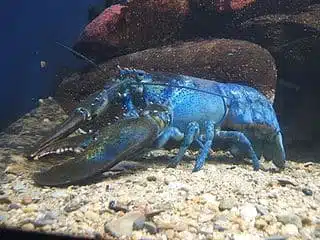The color blue is one of the rarest occurring colors in nature. And it is even more limited in the animal kingdom. Sure, you can make the case that what about the skies and the oceans?
But these elements of our planet are not true blue but only appear blue to our eyes. Perhaps this may sound counter-intuitive, but the appearance of the sky and ocean as blue is only a result of the unique interaction their constituent particles have with sunlight.
The sky consists of several colorless gases and molecules. These molecules scatter blue light more effectively because of its short wavelength as opposed to red light, which has a longer wavelength, hence the blue color.
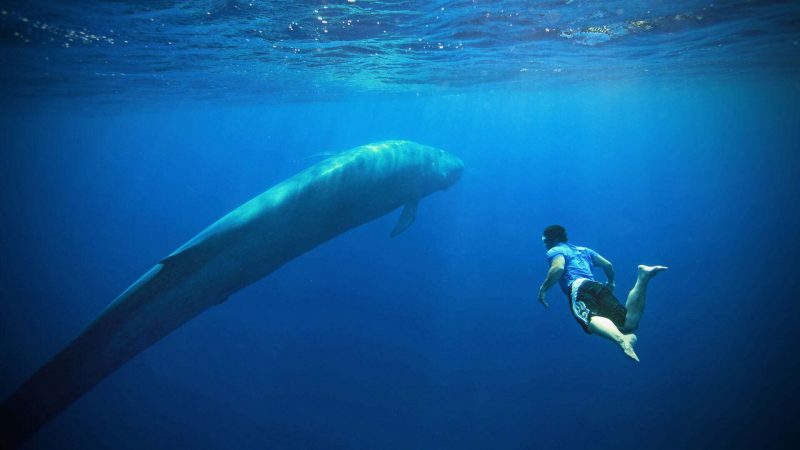
In the case of the oceans, we can agree that water is colorless. But the ocean’s depths appear blue as the red part of the light spectrum is absorbed by the water. Thus, allowing blue light to be reflected all through. Now you may ask, what does all this have to do with endangered blue animals?
Like the skies and oceans, most animals on this list only gain their blue color from their interaction with light. And most of them have no actual blue color or pigmentation.
They are able to do this by having a structural coloration. And a physical phenomenon known as iridescence makes it possible. Therefore, their appearance is primarily due to our visual perception more than anything else.
Structural Coloration and Iridescence In Blue Animals
Structural coloration is a fascinating phenomenon found in various creatures, plants, and even some plankton. It hinges on the unique design of their outer surfaces, which are studded with microscopic pores that manipulate light waves. These pores work their magic by reflecting exclusively the enchanting blue hues of the color spectrum.
Furthermore, within this realm of structural coloration lies the mesmerizing world of iridescence. It emerges from the same structural prowess, causing light to scatter and dance upon the skin and feathers of these remarkable creatures, painting them with a spectrum of shimmering colors.
Most Endangered Blue Animals
While these animals may possess rare and stunning colors, they themselves were not inherently scarce in the wild. It’s the impact of human actions, including activities like logging, trophy hunting, the pet trade, and commercial fishing, along with broader challenges like climate change and genetic diversity depletion, that have pushed their populations to alarming lows.
These animals now find themselves categorized by the International Union for Conservation of Nature (IUCN) as either threatened or near threatened. The IUCN, a global authority in nature conservation, recognizes the urgent need to safeguard these creatures and their habitats.
10. Blue Crane (Grus paradise)
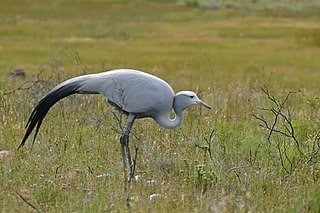
Sometimes known as the paradise crane or Stanley crane, this ground-dwelling bird is native only to southern Africa. A large majority are found in South Africa.
Few blue cranes are found in other South African countries like Namibia, Zimbabwe, and Botswana. Perhaps this is why the blue crane holds the title of South Africa’s national bird. Besides, the blue crane is culturally significant to many of the local tribes in the country. And local conservationists have intensified efforts to improve this blue animal’s vulnerable status on the IUCN Red list.
In contrast to many other crane species, the blue crane does not migrate over long distances for breeding. They also do so for feeding purposes. They are altitudinal migrants in that they usually nest and feed in grasslands at high altitudes. But these birds move down to planes with lower altitudes and warmer temperatures during winter.
Mating in this species typically follows an elaborate courtship ritual. And both parents guard and incubate their eggs till they hatch. Also, the eggs hardly number above two [numbers below or above are uncommon]. And when they mature, they can grow up to 120cm tall, with a wingspan of 200cm.
Furthermore, the blue crane’s mode of feeding is not consistent. They can be herbivorous or carnivorous, depending on the proximity and availability of food resources.
9. Antarctic Blue Whale (Balaenoptera musculus)
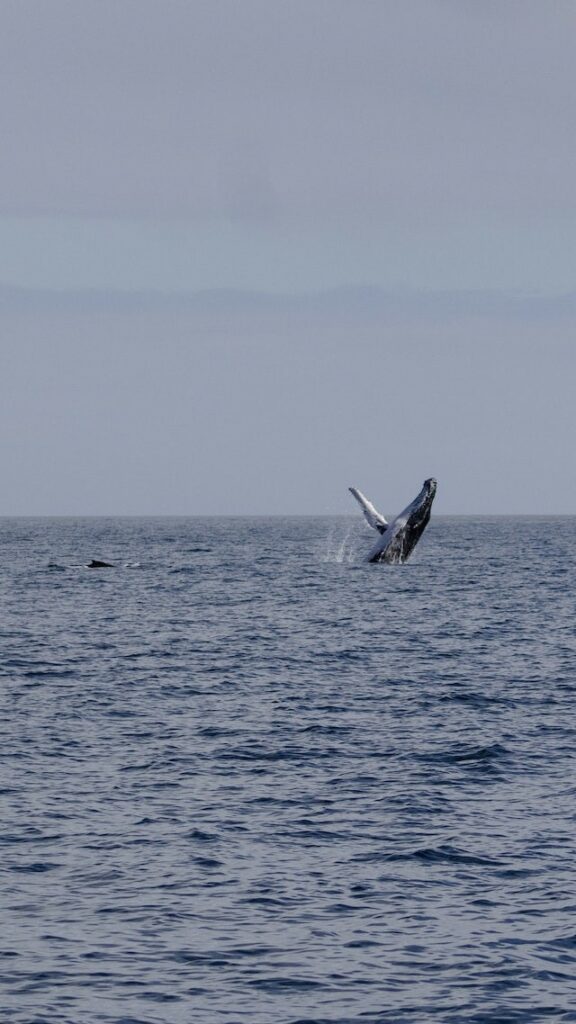
With record lengths of up to 30m and weighing up to 200 tons, the Antarctic blue whale is the most immense sea or land animal in recorded history. It is 30 times bigger than the African elephant, the most giant land animal, and even larger than the giant prehistoric dinosaurs.
The blue whale only looks true blue when underwater, perhaps due to blue light being more visible underwater. Yet, when these animals come to the water’s surface for oxygen, they appear grayish-blue.
Even though they are the earth’s most giant animals, the Antarctic blue whale’s dietary habit is somewhat baffling. They are picky eaters who almost exclusively feed on Krill [small crustaceans that live in large groups called swarms], though sometimes tiny fish and copepods make up their diet.
In contrast to other whales at the top of the marine food chain, like killer whales or sperm whales, the blue whale has no teeth and instead has prickly baleen plates, which it uses to filter seawater when hunting for krill.
Being mammals, the blue whale looks after its young and provides milk for newborns after reproduction. Also, they are primarily solitary and highly monogamous in their mating habits, using loud vocalizations to keep track of mates and other nearby blue whales.
Despite this species being distributed across the southern hemisphere from Antarctica to Australia and New Zealand, they are still considered endangered, primarily due to the reduction of their population by commercial whaling.
8. Congo Peafowl (Afropavo congensis)
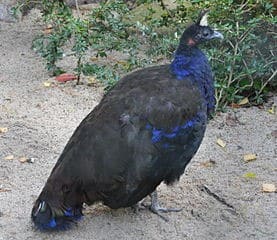
Native to the Congo lowland forests of Africa, this specie represents one of the only three species of Peafowls in existence today, the others being the Indian and Indonesian peafowl.
You probably recognize its Asian counterparts more readily because of their long extravagant plumage. Nevertheless, what the African Peafowl lacks in showiness, it makes up for with distinctiveness.
Unlike other peafowl species, the Congo peafowl is smaller, has a shorter tail, and its feathers have no Ocelli [multi-colored eye spots], resembling an immature Asian peafowl.
The feathers of the African peafowl appear deep blue with a green and violet tinge, an effect of selective structural coloration. However, female peahens do have considerably less blue shade in their plumage.
These blue animals are omnivores, feeding on seeds, fruits, insects, amphibians, and small reptiles in the limited geography which they have found.
Moreso, conservationists have classified this species as vulnerable, and its population decline has been attributed to habitat loss caused by farming, mining, and logging in the Congo Basin and associated surroundings.
7. Blue Iguana (Cyclura lewisi)
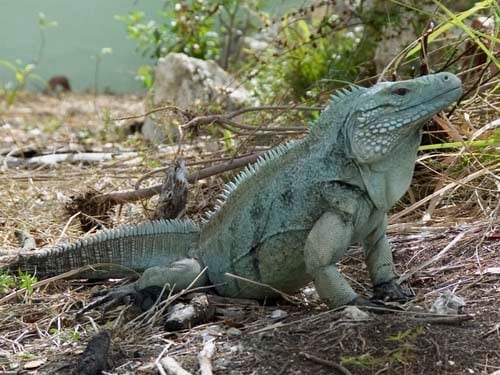
Also known as the Grand Canyon rock iguana, the blue iguana is a lizard endemic only to the Grand Cayman Islands. This reptile gets its name from its colors, which range from turquoise blue to dark grey in males and pale blue to olive green in females.
Interestingly though, the blue iguana doesn’t possess any blue skin pigmentation. Its blue color becomes prominent when the animal changes its skin’s crystal cell structure, enabling it to reflect blue colors.
It uses this structural coloration to evoke different moods, the most important of which is its readiness to mate. Hence, the blue color is most prominent from April to June, which is its breeding season.
At maturity, this solitary herbivore can grow up to 150cm and weigh up to 15 kg. Yet its size doesn’t deter predators like dogs and feral cats from hunting it as prey.
They love lowland grasslands close to a water source where they can easily feed on flowers, fruits, and leaves from within reach of trees.
6. Spix’s Macaw (Cyanopsitta spixii)
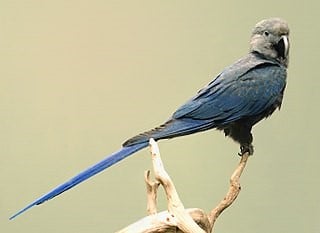
The Spix’s macaw, a parrot species christened in honor of the German naturalist Johann Baptiste Von Spix who first encountered it in 1819, occupies the unenviable title of the rarest macaw on Earth. With a perilously small population numbering just over 200 individuals, it teeters on the brink of extinction, earning the dreaded classification of “critically endangered” by the IUCN.
This extraordinary bird hails from the lush tropical forests of Brazil and is famous for its captivating structural blue plumage, serving as the inspiration for the lead character in the 2011 Hollywood animation film, “Rio.” Such is the enduring charm of macaws that the movie even spawned a 2016 sequel.
In a glimmer of hope, conservationists have embarked on selective breeding and reintroduction efforts, aiming to rekindle the Spix’s macaw’s presence in its native Brazilian habitat. In the wild, these avian gems form tight-knit family units, foraging together on a diet of fruits, nuts, and seeds. When fully matured, they can reach impressive lengths of up to 56 centimeters and weigh as much as 320 grams.
These sedentary birds, which do not embark on migratory journeys, boast a lifespan spanning from 25 to 40 years. What truly sets them apart is their gift of mimicry, often imitating the songs of other birds and even the human voice.
Sadly, their existence is under siege primarily from the clutches of illegal captivity by private pet traders. Being social creatures, they struggle when isolated in captivity, further compounding the woes of their dwindling population.
5. Blue American Lobster (Homarus americanus)
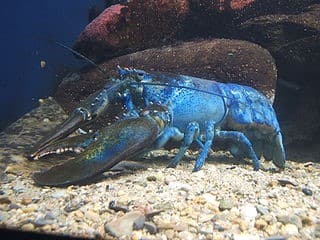
The inclusion of the Blue American lobster in this list is debatable, and this is because members of the genus H. americanus typically have red coloration. Another reason is that the entire specie is considered of most minor concern by the IUCN.
Notwithstanding, the blue American lobster deserves mention because this animal is so rare that the chances of it occurring in nature is 1 in 2 million. Likewise, the chances of catching one are even slimmer at one in 200 million.
For this reason, blue lobsters are rarely found in the wild and are mostly seen only in aquariums and conservatories.
The blue lobster gets its color due to a genetic mutation that makes it produce an inordinate amount of a protein that combines with Astaxanthin [its natural red pigment] to form a blue compound known as Crustacyanin.
Though red lobsters are almost everywhere and regularly sold as an expensive delicacy, blue lobsters caught alive are either put in aquariums or released back into the ocean because of their rare status.
4. Blue Morpho Butterfly (Morpho melaneus)
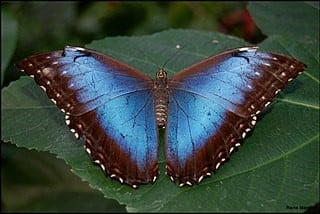
The blue morpho butterfly is endemic to the tropical rainforest and savannah of Central and South America, particularly the Amazon Forest and Cerrado savannah of Brazil.
With a wingspan of 5-8 inches, it is the most giant butterfly in the Morpho genus [which contains over 30 species], and it is considered one of the largest butterflies of any species in the world. They feed mainly on rotting fruits and nectar near the forest floor and lay their eggs on the underside of low-growing plants.
M.morpho has arguably the most ingenious use of iridescent coloring in butterflies. Though its dorsal wings are bright blue with black edges, its underside is brown with big pronounced eyespots.
This blue-brown coloration makes the blue morpho butterfly look like it’s disappearing and reappearing when flying. When at rest, the eyespot under the wings makes it look intimidating to potential predators.
Generally, this strikingly beautiful blue animal is preyed upon by frogs, lizards, and birds, but the primary cause of this species’ endangerment remains deforestation and captivity by private collectors.
3. Tahitian Lorikeet (Vini peruviana)
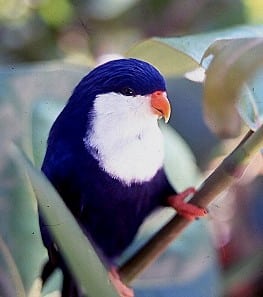
Also called the blue lorikeet, this medium-sized arboreal parrot is native to Tahiti and surrounding islands in the South Pacific, including French Polynesia and the Cook Islands.
The bird is only 18cm long with dark blue plumage and white colors around its face, throat, and chest. The blue lorikeet typically lives in flocks, roosting on coconut palm trees, and feeding on nectar and pollen. They also feed on bay cedar, mulberries, and sometimes tiny insects.
The IUCN classifies the species as vulnerable and its decline is due to the introduction of invasive species competing with it for food and avian malaria caused by mosquitoes.
2. Blue Glaucus (Glaucus atlanticus)
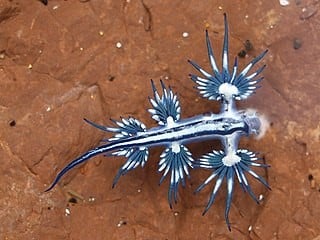
Meet the enigmatic blue glaucus, affectionately known as the blue sea slug or blue sea dragon, a nudibranch – a soft-bodied gastropod mollusc that roams the pelagic realms of temperate seas and oceans worldwide.
These elegant creatures lack appendages for traditional movement, relying on a gas-filled sac in their stomachs to gracefully drift across the ocean’s surface. In true nudibranch fashion, they possess hermaphroditic traits, with both individuals participating in egg-laying post-mating.
While they may be small, they’re packing some potent poison, albeit not of their own making. Their venom is acquired through a rather curious dietary choice – they dine on the Portuguese man of war, a venomous hydrozoan. Remarkably, the blue glaucus is immune to the hydrozoan’s venom, allowing it to consume and store nematocysts (stinging cells) from its prey in finger-like cerata. This pilfered venom serves both as a weapon for hunting and as a shield against potential predators.
However, despite their intriguing adaptations, the blue glaucus faces a dire fate. The International Union for Conservation of Nature (IUCN) lists this floating marvel as endangered. Its dwindling numbers are primarily attributed to pollution, ocean acidification, and the pet trade, underscoring the pressing need for conservation efforts to protect these captivating creatures.
1. Electric Blue Gecko (Lygodactylus williamsi)
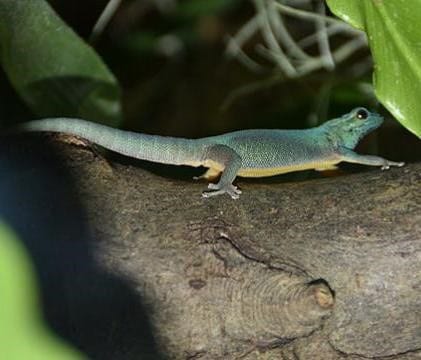
Also known as the Tanzanian blue gecko, this species is native to a small patch of the Tanzanian forest, typically found on screwpine trees. Though it is termed electric, the electric blue gecko isn’t electrogenic, and its name only captures the vibrancy of its blue colors.
The species’ steadfast commitment to a single territory which continues to reduce in size, is perhaps why the blue gecko is fast dwindling in population and considered critically endangered.
Dominant males of the specie are bright blue with black throat stripes and orange underbellies. However, females have a more bronze-brown to green color with no throat stripes.
They are very small and can only grow up to 2-3 inches at full maturity, though their considerably long tails make them super fast runners and gliders.
Summary of the most endangered blue animals
We hope you had the best time learning about these blue animals threatened by extinction as a result of several different factors.
If you learned something new, there is even more exciting stuff to be discovered in this article about black animals or white animals around the world.
- Animals and Wildlife in Colorado - April 24, 2024
- Best Places to see Sloths - April 24, 2024
- Where to See Alligators in the Wild - April 24, 2024

